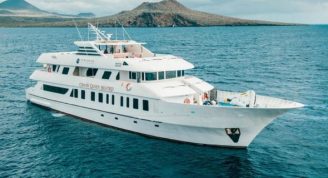Description
Our itinerary together begins on San Cristóbal Island and Puerto Baquerizo Moreno, the capital of the Galápagos Province. On our first afternoon, we visit Cerro Colorado, breeding centre of the islands’ famous giant tortoises amid a fantastic deciduous forest. We sail north overnight, to awake at the sunken caldera of Genovesa Island, a privileged place to visit amid thousands of marine birds. Back in the central islands, on Thursday we learn about Buccaneer Cove’s distant and recent history aboard our pangas, before exploring the underwater realm, snorkeling or aboard the glass-bottom boat. Across the way, we disembark at the popular site of Puerto Egas, a great place to see land and marine birds amid a landscape of tuff-stone layers and lava flows.
Motoring all night, we find ourselves in the youngest islands of the Galápagos the next day, visiting Punta Espinoza with its amazing combination of barrenness and abundant wildlife. Highlights include hawks, penguins and the flightless cormorant. Later, at Tagus Cove, an uphill hike takes us to the rim of Darwin Crater and some lovely views, following by a panga ride to spot local wildlife, a swim, kayak or snorkel. We continue our exploration of Isabela Island the following day, at Urbina Bay, the intriguing result of an uplifting of the ocean, home to large and very colourful Galápagos land iguanas, and then at Punta Vicente Roca with its abundant wildlife and, hopefully, sightings of green sea turtles. Sunday sees us anchor to visit the red beach of Rábida Island and its large colony of sea lions, marine iguanas, mockingbirds, yellow warblers and several species of Darwin’s finches. In the afternoon, we visit the north shore of Santa Cruz, host to Cerro Dragon (Dragon Hill), home to land iguanas and with a trail that offers a beautiful view of the bay.
Wherever we sail, whatever we do, all the crew aboard the Isabela II will do our utmost to ensure your Galápagos experience is truly, deeply moving and memorable.










